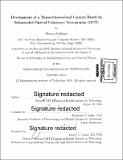| dc.contributor.advisor | Benjamin J. Vakoc. | en_US |
| dc.contributor.author | Siddiqui, Meena | en_US |
| dc.contributor.other | Harvard--MIT Program in Health Sciences and Technology. | en_US |
| dc.date.accessioned | 2016-02-29T15:01:16Z | |
| dc.date.available | 2016-02-29T15:01:16Z | |
| dc.date.copyright | 2015 | en_US |
| dc.date.issued | 2015 | en_US |
| dc.identifier.uri | http://hdl.handle.net/1721.1/101339 | |
| dc.description | Thesis: Ph. D., Harvard-MIT Program in Health Sciences and Technology, 2015. | en_US |
| dc.description | Cataloged from PDF version of thesis. | en_US |
| dc.description | Includes bibliographical references (pages 147-152). | en_US |
| dc.description.abstract | Optical coherence tomography (OCT) allows label-free, three-dimensional imaging of tissue structure. Current implementations of OCT can either image over long depth ranges at slow imaging speeds, or over limited depth ranges at high speeds. Here, we describe a new OCT paradigm that supports simultaneous high speed and long depth range imaging through subsampling bandwidth compression. We show that this requires replacing the conventional wavelength-swept OCT laser source with a wavelength-stepped laser. First we validated this concept by modifying a slow, conventional wavelength-swept source with an intra-cavity Fabry-Perot etalon to provide a wavelength-stepped output. Using this source in an existing OCT system, we show that we can passively compress signals across a large depth range into a limited RF bandwidth. Next, to demonstrate high-speed optical domain subsampled imaging, we developed a novel wavelength-stepped laser source based on intra-cavity pulse compression/stretching; this source provided an A-line rate of ~19 MHz. We then built a polarization-based quadrature interferometer to remove imaging artifacts induced by subsampling and comple-conjugate ambiguity. A calibration and error compensation method was developed to fully remove residual artifacts in the image. We combined the high speed laser and the interferometer to demonstrate the first OCT camera-like imaging across several centimeters of depth range. The optically subsampled OCT technology developed in this work may offer a new three-dimensional camera platform for endoscopic and intraoperative imaging applications. | en_US |
| dc.description.statementofresponsibility | by Meena Siddiqui. | en_US |
| dc.format.extent | 152 pages | en_US |
| dc.language.iso | eng | en_US |
| dc.publisher | Massachusetts Institute of Technology | en_US |
| dc.rights | M.I.T. theses are protected by copyright. They may be viewed from this source for any purpose, but reproduction or distribution in any format is prohibited without written permission. See provided URL for inquiries about permission. | en_US |
| dc.rights.uri | http://dspace.mit.edu/handle/1721.1/7582 | en_US |
| dc.subject | Harvard--MIT Program in Health Sciences and Technology. | en_US |
| dc.title | Development of a three-dimensional camera based on subsampled optical coherence tomography (OCT) | en_US |
| dc.title.alternative | Development of a 3-dimensional camera based on subsampled optical coherence tomography (OCT) | en_US |
| dc.title.alternative | Development of a 3-D camera based on subsampled optical coherence tomography (OCT) | en_US |
| dc.type | Thesis | en_US |
| dc.description.degree | Ph. D. | en_US |
| dc.contributor.department | Harvard University--MIT Division of Health Sciences and Technology | |
| dc.identifier.oclc | 938897920 | en_US |
